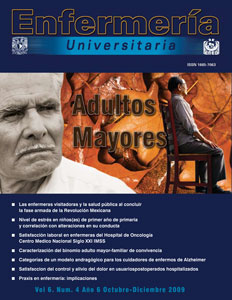Caracterización del binomio adulto mayor-familiar de convivencia
Main Article Content
Abstract
Abstract Nurses have sensitivity; knowledge and experience to attend the binomial older adult-relative of coexistence in family context. The purpose of the study was to identify characteristics of the older adult and the relative of coexistence as base to plan actions. The study was descriptive; crosssectional with 96 binomials adult major-relative of greater coexistence. Biographical data and health questionnaire for the older adult and demographic data for the relative applied by means of interview in the homes. We used the statistical program SPSS version 17. Age and sex had significant relation between older adults and relatives of coexistence. Age average; 70 and 45; woman; 59. 4% and 67.7%; married; 56.3% and 72.9; respectively. Relative of coexistence was child (54%) and wife or husband (32%); majority were woman with low level of education (65%) and occupation of the household work (64%). The coexistence is favorable for the health because there is a greater control of the risk conducts. Relevance of the characteristics of the binomial older adult-relative of coexistence for promotion and prevention actions in the homes; oriented to fortify the relation and to develop ability in the attention to the older adult.
Publication Facts
Reviewer profiles N/A
Author statements
- Academic society
- N/A
- Publisher
- Universidad Nacional Autónoma de México
Article Details
Dimensions citation
MÉTRICAS
Enfermería Universitaria by Universidad Nacional Autónoma de México it is distributed under the License Creative Commons Attribution - NonCommercial - NoDerivatives 4.0 International
Accepted and published articles become open-access under the terms of the Creative Commons CC BY-NC-ND 4.0 license, which authorizes the reproduction and sharing without commercial purposes, provided the corresponding acknowledgments to their authors. Authors are allowed to manage a self-archive copy of the article’s published version so that they can open-access it in their personal or institutional web pages, and/or any other broad-diffusion space.


